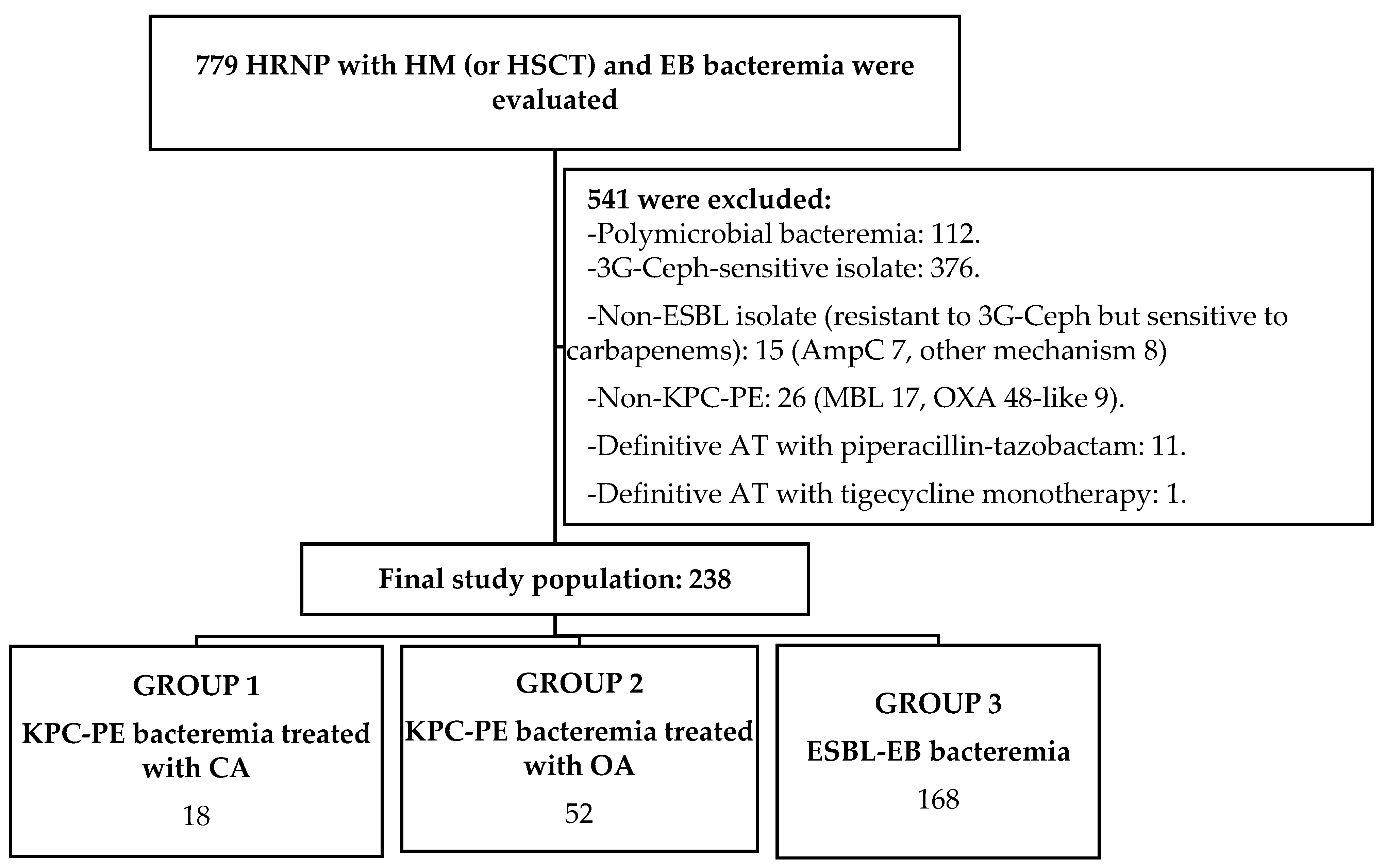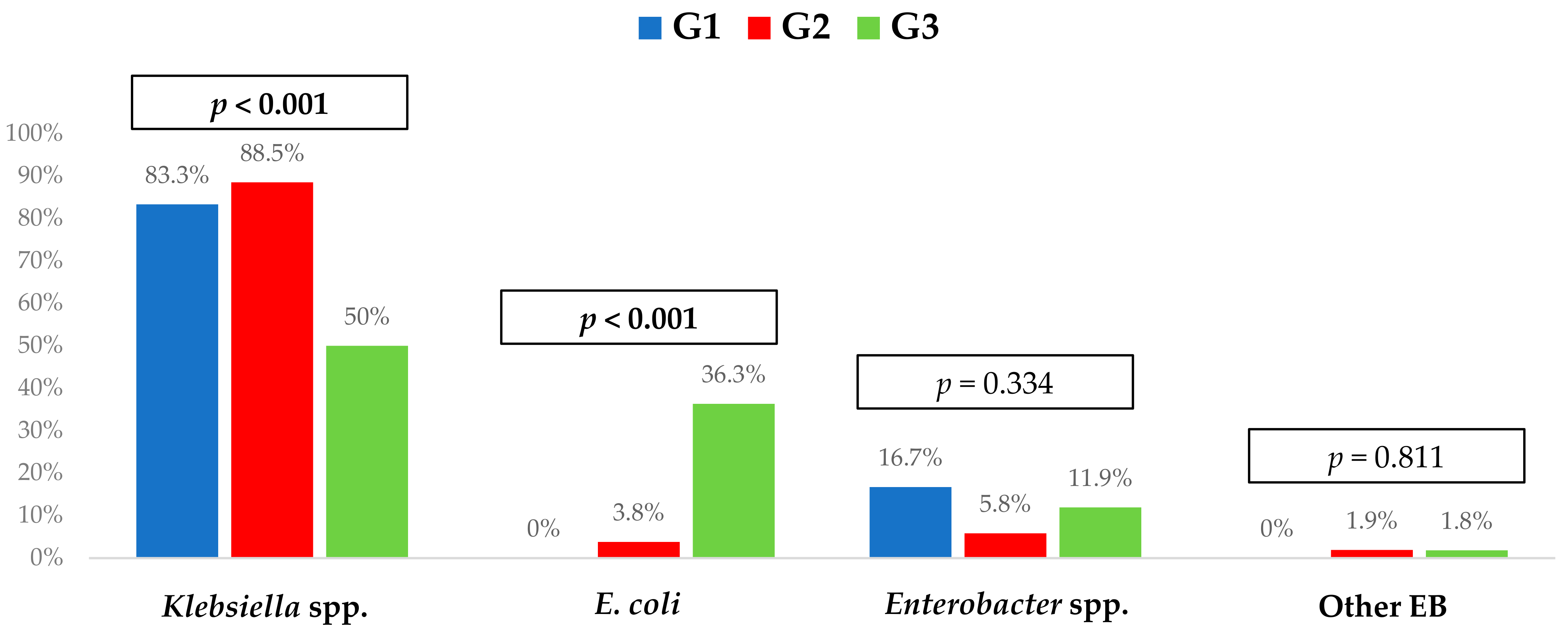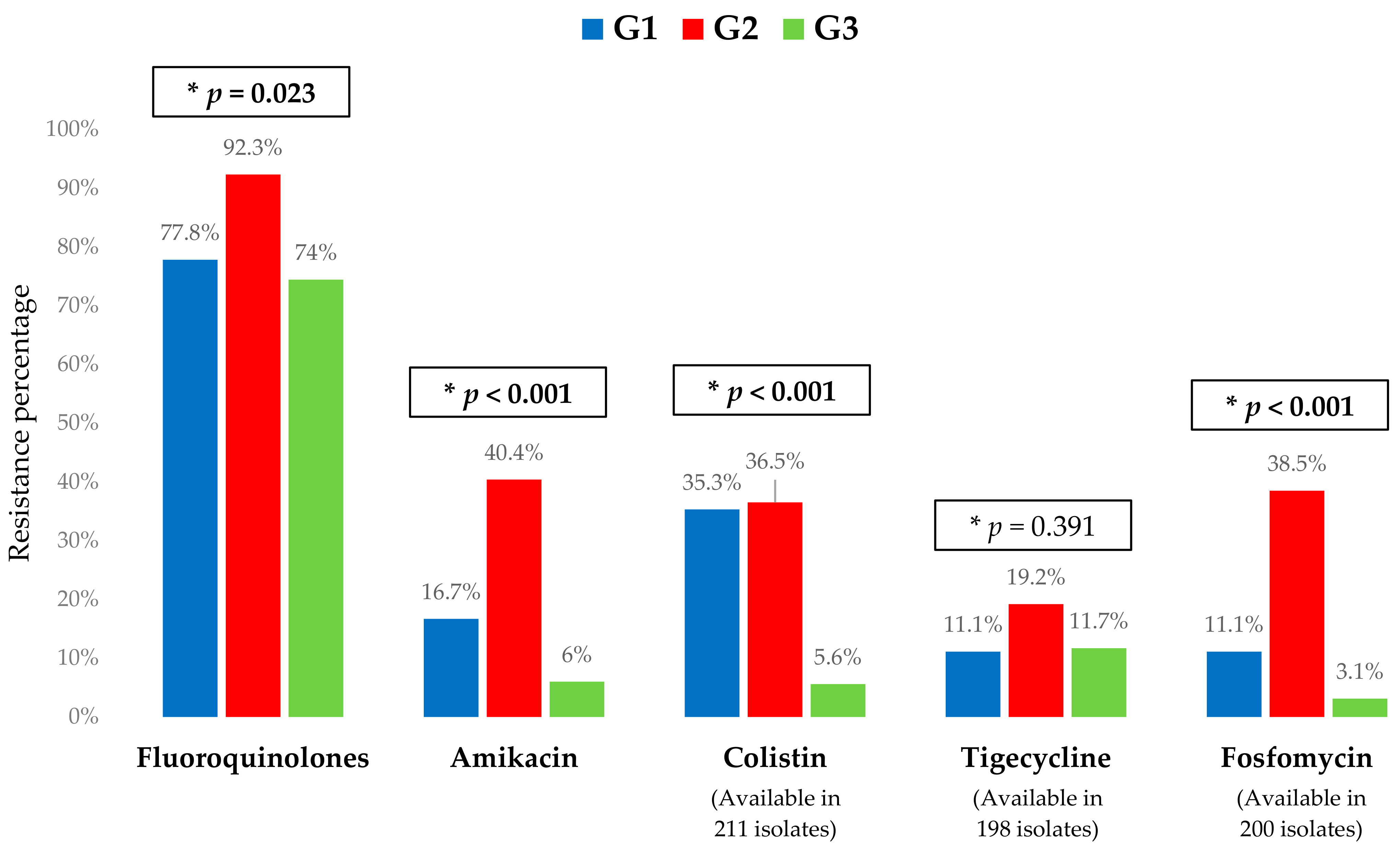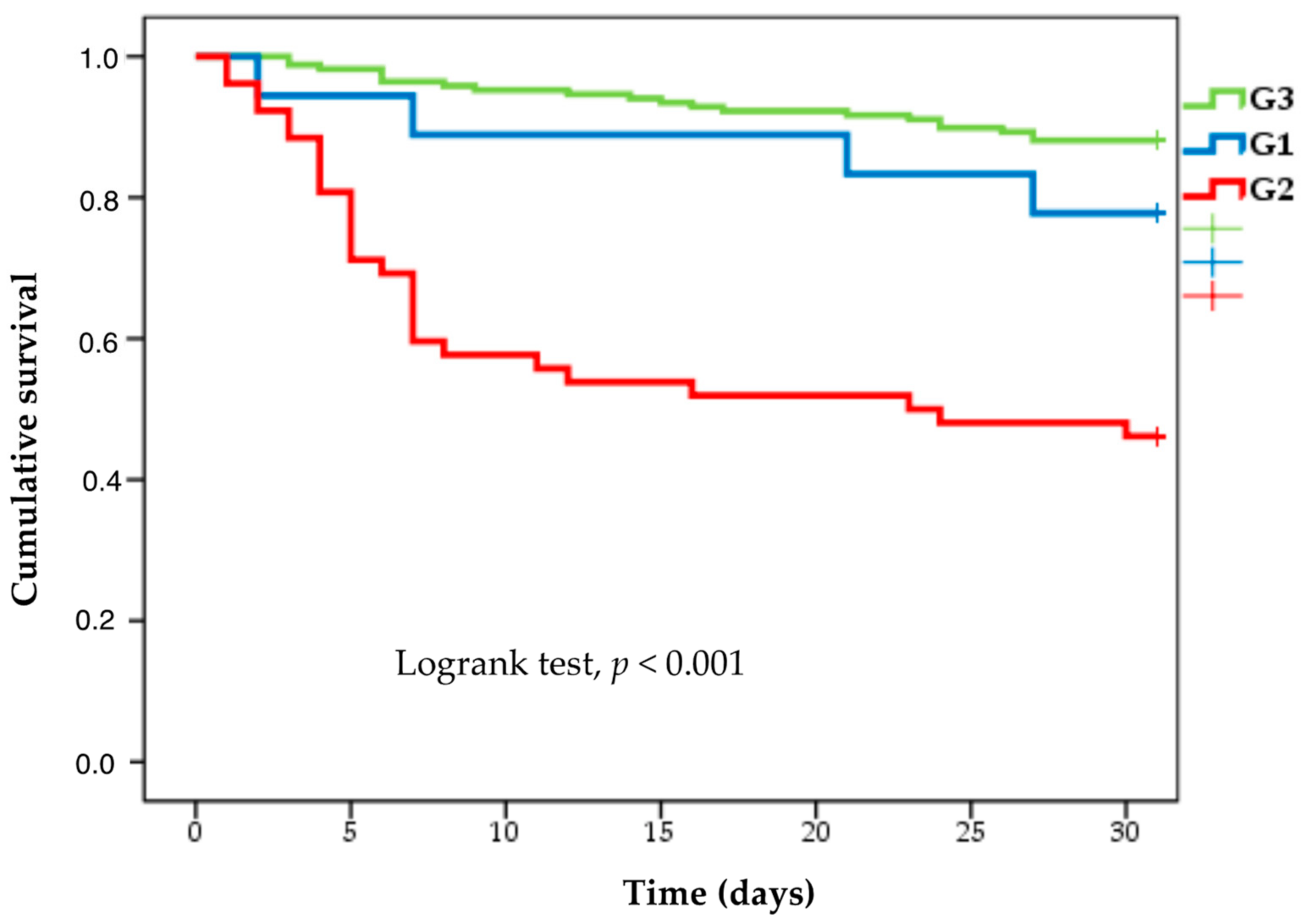Ceftazidime–Avibactam Improves Outcomes in High-Risk Neutropenic Patients with Klebsiella pneumoniae Carbapenemase-Producing Enterobacterales Bacteremia
Abstract
1. Introduction
2. Materials and Methods
2.1. Setting, Patients, and Study Design
2.2. Definitions
2.3. Microbiological Studies
2.4. Statistical Analysis
3. Results
4. Discussion
Author Contributions
Funding
Institutional Review Board Statement
Informed Consent Statement
Data Availability Statement
Acknowledgments
Conflicts of Interest
References
- Trecarichi, E.M.; Pagano, L.; Candoni, A.; Pastore, D.; Cattaneo, C.; Fanci, R.; Nosari, A.; Caira, M.; Spadea, A.; Busca, A.; et al. HeMABIS Registry—SEIFEM Group, Italy. Current epidemiology and antimicrobial resistance data for bacterial bloodstream infections in patients with hematologic malignancies: An Italian multicentre prospective survey. Clin. Microbiol. Infect. 2015, 21, 337–343. [Google Scholar] [CrossRef] [PubMed]
- Averbuch, D.; Tridello, G.; Hoek, J.; Mikulska, M.; Akan, H.; Yanez San Segundo, L.; Pabst, T.; Özçelik, T.; Klyasova, G.; Donnini, I.; et al. Antimicrobial Resistance in Gram-Negative Rods Causing Bacteremia in Hematopoietic Stem Cell Transplant Recipients: Intercontinental Prospective Study of the Infectious Diseases Working Party of the European Bone Marrow Transplantation Group. Clin. Infect. Dis. 2017, 65, 1819–1828. [Google Scholar] [CrossRef]
- Cruz-Vargas, S.A.; García-Muñoz, L.; Cuervo-Maldonado, S.I.; Álvarez-Moreno, C.A.; Saavedra-Trujillo, C.H.; Álvarez-Rodríguez, J.C.; Arango-Gutiérrez, A.; Gómez-Rincón, J.C.; García-Guzman, K.; Leal, A.L.; et al. Molecular and Clinical Data of Antimicrobial Resistance in Microorganisms Producing Bacteremia in a Multicentric Cohort of Patients with Cancer in a Latin American Country. Microorganisms 2023, 11, 359. [Google Scholar] [CrossRef] [PubMed]
- Castanheira, M.; Deshpande, L.M.; Mendes, R.E.; Canton, R.; Sader, H.S.; Jones, R.N. Variations in the Occurrence of Resistance Phenotypes and Carbapenemase Genes Among Enterobacteriaceae Isolates in 20 Years of the SENTRY Antimicrobial Surveillance Program. Open Forum Infect. Dis. 2019, 6 (Suppl. S1), S23–S33. [Google Scholar] [CrossRef] [PubMed]
- Trecarichi, E.M.; Giuliano, G.; Cattaneo, C.; Ballanti, S.; Criscuolo, M.; Candoni, A.; Marchesi, F.; Laurino, M.; Dargenio, M.; Fanci, R.; et al. Hematologic Malignancies Associated Bloodstream Infections Surveillance (HEMABIS) registry—Sorveglianza Epidemiologica Infezioni Fungine in Emopatie Maligne (SEIFEM) group, Italy. Bloodstream infections due to Gram-negative bacteria in patients with hematologic malignancies: Updated epidemiology and risk factors for multidrug-resistant strains in an Italian perspective survey. Int. J. Antimicrob. Agents 2023, 61, 106806. [Google Scholar] [CrossRef] [PubMed]
- Herrera, F.; Laborde, A.; Jordán, R.; Berruezo, L.; Roccia Rossi, I.; Valledor, A.; Lambert, S.; Pereyra, M.; Nenna, A.; Dictar, M.; et al. Current Epidemiology of Bacteremia in Patients with Hematological Malignancies and Hematopoietic Stem Cell Transplantation and the Impact of Antibiotic Resistance on Survival. In Proceedings of the 31st of European Congress of Clinical Microbiology & Infectious Diseases (ECCMID), Vienna, Austria, 9–12 July 2021. [Google Scholar]
- Torres, D.; Herrera, F.; Laborde, A.; Mañez, N.; Lambert, S.; Jordán, R.; Costantini, P.; Berruezo, L.; Pereyra, M.L.; Suchowiercha, N.; et al. Bacteremia in cancer patients: Has the COVID-19 pandemic changed the epidemiology? In proceedings of the 33rd of European Congress of Clinical Microbiology & Infectious Diseases (ECCMID), Copenhagem, Denmark, 15–18 April 2023.
- Trecarichi, E.M.; Pagano, L.; Martino, B.; Candoni, A.; Di Blasi, R.; Nadali, G.; Fianchi, L.; Delia, M.; Sica, S.; Perriello, V.; et al. Bloodstream infections caused by Klebsiella pneumoniae in onco-hematological patients: Clinical impact of carbapenem resistance in a multicentre prospective survey. Am. J. Hematol. 2016, 91, 1076–1081. [Google Scholar] [CrossRef]
- Herrera, F.; Laborde, A.; Torre, V.; Jordán, R.; Roccia Rossi, I.; Valledor, A.; Costantini, P.; Dictar, M.; Nenna, A.; Caeiro, J.P.; et al. Bacteremia due to Enterobacteriaceae in cancer patients: Etiology, clinical features and outcome depending on antimicrobial resistance. In Data from ROCAS Study. In Proceedings of the 29th of European Congress of Clinical Microbiology & Infectious Diseases (ECCMID), Amsterdam, The Netherlands, 13–16 April 2019. [Google Scholar]
- Lin, M.Y.; Weinstein, R.A.; Hota, B. Delay of active antimicrobial therapy and mortality among patients with bacteremia: Impact of severe neutropenia. Antimicrob. Agents Chemother. 2008, 52, 3188–3194. [Google Scholar] [CrossRef]
- Martinez-Nadal, G.; Puerta-Alcalde, P.; Gudiol, C.; Cardozo, C.; Albasanz-Puig, A.; Marco, F.; Laporte-Amargós, J.; Moreno-García, E.; Domingo-Doménech, E.; Chumbita, M.; et al. Inappropriate Empirical Antibiotic Treatment in High-risk Neutropenic Patients with Bacteremia in the Era of Multidrug Resistance. Clin. Infect. Dis. 2020, 70, 1068–1074. [Google Scholar] [CrossRef]
- Micozzi, A.; Gentile, G.; Minotti, C.; Cartoni, C.; Capria, S.; Ballarò, D.; Santilli, S.; Pacetti, E.; Grammatico, S.; Bucaneve, G.; et al. Carbapenem-resistant Klebsiella pneumoniae in high-risk haematological patients: Factors favouring spread, risk factors and outcome of carbapenem-resistant Klebsiella pneumoniae bacteremias. BMC Infect. Dis. 2017, 17, 203. [Google Scholar] [CrossRef]
- Paul, M.; Carrara, E.; Retamar, P.; Tängdén, T.; Bitterman, R.; Bonomo, R.A.; de Waele, J.; Daikos, G.L.; Akova, M.; Harbarth, S.; et al. European Society of Clinical Microbiology and Infectious Diseases (ESCMID) guidelines for the treatment of infections caused by multidrug-resistant Gram-negative bacilli (endorsed by European society of intensive care medicine). Clin. Microbiol. Infect. 2022, 28, 521–547. [Google Scholar] [CrossRef] [PubMed]
- Tamma, P.D.; Aitken, S.L.; Bonomo, R.A.; Mathers, A.J.; van Duin, D.; Clancy, C.J. Infectious Diseases Society of America 2023 Guidance on the Treatment of Antimicrobial Resistant Gram-Negative Infections. Clin. Infect. Dis. 2023, ciad428. [Google Scholar] [CrossRef]
- Van Duin, D.; Lok, J.J.; Earley, M.; Cober, E.; Richter, S.S.; Perez, F.; Salata, R.A.; Kalayjian, R.C.; Watkins, R.R.; Doi, Y.; et al. Colistin Versus Ceftazidime-Avibactam in the Treatment of Infections Due to Carbapenem-Resistant Enterobacteriaceae. Clin. Infect. Dis. 2018, 66, 163–171. [Google Scholar] [CrossRef] [PubMed]
- Tumbarello, M.; Trecarichi, E.M.; Corona, A.; De Rosa, F.G.; Bassetti, M.; Mussini, C.; Menichetti, F.; Viscoli, C.; Campoli, C.; Venditti, M.; et al. Efficacy of Ceftazidime-Avibactam Salvage Therapy in Patients with Infections Caused by Klebsiella pneumoniae Carbapenemase-producing K. pneumoniae. Clin. Infect. Dis. 2019, 68, 355–364. [Google Scholar] [CrossRef]
- Tumbarello, M.; Raffaelli, F.; Giannella, M.; Mantengoli, E.; Mularoni, A.; Venditti, M.; De Rosa, F.G.; Sarmati, L.; Bassetti, M.; Brindicci, G.; et al. Ceftazidime-Avibactam Use for Klebsiella pneumoniae Carbapenemase-Producing K. pneumoniae Infections: A Retrospective Observational Multicenter Study. Clin. Infect. Dis. 2021, 73, 1664–1676. [Google Scholar] [CrossRef]
- Castón, J.J.; Cano, A.; Pérez-Camacho, I.; Aguado, J.M.; Carratalá, J.; Ramasco, F.; Soriano, A.; Pintado, V.; Castelo-Corral, L.; Sousa, A.; et al. Impact of ceftazidime/avibactam versus best available therapy on mortality from infections caused by carbapenemase-producing Enterobacterales (CAVICOR study). J. Antimicrob. Chemother. 2022, 77, 1452–1460. [Google Scholar] [CrossRef] [PubMed]
- Chen, Y.; Huang, H.B.; Peng, J.M.; Weng, L.; Du, B. Efficacy and Safety of Ceftazidime-Avibactam for the Treatment of Carbapenem-Resistant Enterobacterales Bloodstream Infection: A Systematic Review and Meta-Analysis. Microbiol. Spectr. 2022, 10, e0260321. [Google Scholar] [CrossRef]
- Castón, J.J.; Lacort-Peralta, I.; Martín-Dávila, P.; Loeches, B.; Tabares, S.; Temkin, L.; Torre-Cisneros, J.; Paño-Pardo, J.R. Clinical efficacy of ceftazidime/avibactam versus other active agents for the treatment of bacteremia due to carbapenemase-producing Enterobacteriaceae in hematologic patients. Int. J. Infect. Dis. 2017, 59, 118–123. [Google Scholar] [CrossRef]
- Micozzi, A.; Minotti, C.; Capria, S.; Cartoni, C.; Trisolini, S.M.; Assanto, G.M.; Barberi, W.; Moleti, M.L.; Santilli, S.; Martelli, M.; et al. Benefits and Safety of Empiric Antibiotic Treatment Active Against KPC-K. pneumoniae in Febrile Neutropenic Patients with Acute Leukemia Who are Colonized with KPC-K. pneumoniae. A 7-Years Retrospective Observational Cohort Study. Infect. Drug Resist. 2023, 16, 695–704. [Google Scholar] [CrossRef]
- Borjan, J.; Shelburne, S.A.; Shelburne, S.A.; Bhatti, M.M.; Aitken, S.L.; Aitken, S.L. 2246. Improved Outcomes for Cancer Patients Treated With Ceftazidime–Avibactam vs. Polymyxin-Containing Regimens for Carbapenem-Resistant Enterobacteriaceae Bacteremia. Open Forum Infect. Dis. 2019, 6 (Suppl. S2), S768. [Google Scholar] [CrossRef]
- Alghamdi, A.; AlQahtani, H.; Albilal, S.; Mater Almutairi, M.; Alobaidallah, N.; Alghamdi, L.; Alfayez, A.; Almangour, T.; Al-Jedai, A. Ceftazidime-avibactam use for the treatment of OXA-48- and/or New Delhi metallo-β-lactamase-producing Enterobacterales in cancer patients: A retrospective observational study. Ann. Saudi Med. 2023, 43, 373–379. [Google Scholar] [CrossRef]
- Freifeld, A.G.; Bow, E.J.; Sepkowitz, K.A.; Boeckh, M.J.; Ito, J.I.; Mullen, C.A.; Raad, I.I.; Rolston, K.V.; Young, J.A.; Wingard, J.R. Infectious Diseases Society of America. Clinical practice guideline for the use of antimicrobial agents in neutropenic patients with cancer: 2010 update by the Infectious Diseases Society of America. Clin. Infect. Dis. 2011, 52, e56–e93. [Google Scholar] [CrossRef]
- Averbuch, D.; Orasch, C.; Cordonnier, C.; Livermore, D.M.; Mikulska, M.; Viscoli, C.; Gyssens, I.C.; Kern, W.V.; Klyasova, G.; Marchetti, O.; et al. ECIL4, a joint venture of EBMT, EORTC, ICHS, ESGICH/ESCMID and ELN. European guidelines for empirical antibacterial therapy for febrile neutropenic patients in the era of growing resistance: Summary of the 2011 4th European Conference on Infections in Leukemia. Haematologica 2013, 98, 1826–1835, Erratum in Haematologica 2014, 99, 400. [Google Scholar] [CrossRef]
- Horan, T.C.; Andrus, M.; Dudeck, M.A. CDC/NHSN surveillance definition of health care-associated infection and criteria for specific types of infections in the acute care setting. Am. J. Infect. Control 2008, 36, 309–332. [Google Scholar] [CrossRef] [PubMed]
- Friedman, N.D.; Kaye, K.S.; Stout, J.E.; McGarry, S.A.; Trivette, S.L.; Briggs, J.P.; Lamm, W.; Clark, C.; MacFarquhar, J.; Walton, A.L.; et al. Health care-associated bloodstream infections in adults: A reason to change the accepted definition of community-acquired infections. Ann. Intern. Med. 2002, 137, 791–797. [Google Scholar] [CrossRef] [PubMed]
- Singer, M.; Deutschman, C.S.; Seymour, C.W.; Shankar-Hari, M.; Annane, D.; Bauer, M.; Bellomo, R.; Bernard, G.R.; Chiche, J.D.; Coopersmith, C.M.; et al. The Third International Consensus Definitions for Sepsis and Septic Shock (Sepsis-3). JAMA 2016, 315, 801–810. [Google Scholar] [CrossRef]
- Harris, P.N.A.; Tambyah, P.A.; Lye, D.C.; Mo, Y.; Lee, T.H.; Yilmaz, M.; Alenazi, T.H.; Arabi, Y.; Falcone, M.; Bassetti, M.; et al. Effect of Piperacillin-Tazobactam vs Meropenem on 30-Day Mortality for Patients with E. coli or Klebsiella pneumoniae Bloodstream Infection and Ceftriaxone Resistance: A Randomized Clinical Trial. JAMA 2018, 320, 984–994, Erratum in JAMA 2019, 321, 2370. [Google Scholar] [CrossRef]
- Magiorakos, A.P.; Srinivasan, A.; Carey, R.B.; Carmeli, Y.; Falagas, M.E.; Giske, C.G.; Harbarth, S.; Hindler, J.F.; Kahlmeter, G.; Olsson-Liljequist, B.; et al. Multidrug-resistant, extensively drug-resistant and pandrug-resistant bacteria: An international expert proposal for interim standard definitions for acquired resistance. Clin. Microbiol. Infect. 2012, 18, 268–281. [Google Scholar] [CrossRef] [PubMed]
- Perez, F.; Adachi, J.; Bonomo, R.A. Antibiotic-resistant gram-negative bacterial infections in patients with cancer. Clin Infect Dis. 2014, 59 (Suppl. S5), S335–S339. [Google Scholar] [CrossRef]
- Protocolos de PCR-Multiplex Para Gram Negativos. Available online: http://antimicrobianos.com.ar/2023/06/protocolo-de-pcr-para-la-deteccion-del-gen-ctx-m/ (accessed on 13 January 2024).
- Tofas, P.; Skiada, A.; Angelopoulou, M.; Sipsas, N.; Pavlopoulou, I.; Tsaousi, S.; Pagoni, M.; Kotsopoulou, M.; Perlorentzou, S.; Antoniadou, A.; et al. Carbapenemase-producing Klebsiella pneumoniae bloodstream infections in neutropenic patients with haematological malignancies or aplastic anaemia: Analysis of 50 cases. Int. J. Antimicrob. Agents 2016, 47, 335–339. [Google Scholar] [CrossRef]
- Freire, M.P.; Pierrotti, L.C.; Filho, H.H.; Ibrahim, K.Y.; Magri, A.S.; Bonazzi, P.R.; Hajar, L.; Diz, M.P.; Pereira, J.; Hoff, P.M.; et al. Infection with Klebsiella pneumoniae carbapenemase (KPC)-producing Klebsiella pneumoniae in cancer patients. Eur. J. Clin. Microbiol. Infect. Dis. 2015, 34, 277–286. [Google Scholar] [CrossRef]
- Girmenia, C.; Rossolini, G.M.; Piciocchi, A.; Bertaina, A.; Pisapia, G.; Pastore, D.; Sica, S.; Severino, A.; Cudillo, L.; Ciceri, F.; et al. Gruppo Italiano Trapianto Midollo Osseo (GITMO). Infections by carbapenem-resistant Klebsiella pneumoniae in SCT recipients: A nationwide retrospective survey from Italy. Bone Marrow Transpl. 2015, 50, 282–288. [Google Scholar] [CrossRef]
- Herrera, F.; Torres, D.; Laborde, A.; Berruezo, L.; Jordán, R.; Roccia Rossi, I.; Valledor, A.; Costantini, P.; Dictar, M.; Nenna, A.; et al. Development of a Clinical Score to Stratify the Risk for Carbapenem-resistant Enterobacterales Bacteremia in Patients with Cancer and Hematopoietic Stem Cell Transplantation. Antibiotics 2023, 12, 226. [Google Scholar] [CrossRef] [PubMed]
- Shirley, M. Ceftazidime-Avibactam: A Review in the Treatment of Serious Gram-Negative Bacterial Infections. Drugs 2018, 78, 675–692. [Google Scholar] [CrossRef]
- Hachem, R.; Reitzel, R.; Rolston, K.; Chaftari, A.M.; Raad, I. Antimicrobial Activities of Ceftazidime-Avibactam and Comparator Agents against Clinical Bacteria Isolated from Patients with Cancer. Antimicrob. Agents Chemother. 2017, 61, e02106-16. [Google Scholar] [CrossRef] [PubMed]
- Falcone, M.; Paterson, D. Spotlight on ceftazidime/avibactam: A new option for MDR Gram-negative infections. J. Antimicrob. Chemother. 2016, 71, 2713–2722. [Google Scholar] [CrossRef] [PubMed]
- Nichols, W.W.; Bradford, P.A.; Stone, G.G. The primary pharmacology of ceftazidime/avibactam: In vivo translational biology and pharmacokinetics/pharmacodynamics (PK/PD). J. Antimicrob. Chemother. 2022, 77, 2341–2352. [Google Scholar] [CrossRef] [PubMed]
- Tran, T.B.; Velkov, T.; Nation, R.L.; Forrest, A.; Tsuji, B.T.; Bergen, P.J.; Li, J. Pharmacokinetics/pharmacodynamics of colistin and polymyxin B: Are we there yet? Int. J. Antimicrob. Agents 2016, 48, 592–597. [Google Scholar] [CrossRef]
- Tsuji, B.T.; Pogue, J.M.; Zavascki, A.P.; Paul, M.; Daikos, G.L.; Forrest, A.; Giacobbe, D.R.; Viscoli, C.; Giamarellou, H.; Karaiskos, I.; et al. International Consensus Guidelines for the Optimal Use of the Polymyxins: Endorsed by the American College of Clinical Pharmacy (ACCP), European Society of Clinical Microbiology and Infectious Diseases (ESCMID), Infectious Diseases Society of America (IDSA), International Society for Anti-infective Pharmacology (ISAP), Society of Critical Care Medicine (SCCM), and Society of Infectious Diseases Pharmacists (SIDP). Pharmacotherapy 2019, 39, 10–39. [Google Scholar] [CrossRef]
- Doi, Y. Treatment Options for Carbapenem-resistant Gram-negative Bacterial Infections. Clin. Infect. Dis. 2019, 69 (Suppl. S7), S565–S575. [Google Scholar] [CrossRef]
- Pouch, S.M.; Satlin, M.J. Carbapenem-resistant Enterobacteriaceae in special populations: Solid organ transplant recipients, stem cell transplant recipients, and patients with hematologic malignancies. Virulence 2017, 8, 391–402. [Google Scholar] [CrossRef]
- Bassetti, M.; Peghin, M. How to manage KPC infections. Ther. Adv. Infect. Dis. 2020, 7, 2049936120912049. [Google Scholar] [CrossRef] [PubMed]
- Lalaoui, R.; Javelle, E.; Bakour, S.; Ubeda, C.; Rolain, J.M. Infections Due to Carbapenem-Resistant Bacteria in Patients With Hematologic Malignancies. Front. Microbiol. 2020, 11, 1422. [Google Scholar] [CrossRef] [PubMed]




| Variables | G1 n = 18 n (%) | G2 n = 52 n (%) | G3 n = 168 n (%) | p-Value * |
|---|---|---|---|---|
| Age (years) (median, IQR) | 48 (44–53) | 50 (40–60) | 48 (32–59) | 0.56 |
| Male gender | 12 (66.7) | 35 (67.3) | 107 (63.7) | 0.87 |
| Charlson comorbidity index (median, IQR) | 2 (2–3) | 2 (2–4) | 2 (2–3) | 0.51 |
| Hematological diseases | ||||
| Acute leukemia | 13 (72.2) | 33 (63.5) | 96 (57.1) | 0.38 |
| Lymphoma | 4 (22.2) | 12 (23.1) | 45 (26.8) | 0.82 |
| Multiple myeloma | 1 (5.6) | 2 (3.8) | 11 (6.5) | 0.77 |
| Myelodysplastic syndrome | 0 (0) | 5 (9.6) | 10 (6) | 0.33 |
| Other diseases | 0 (0) | 0 (0) | 6 (3.6) | 0.27 |
| HSCT | 5 (27.8) | 16 (30.8) | 56 (33.3) | 0.86 |
| Allogeneic HSCT | 4 (22.2) | 10 (19.2) | 32 (19) | 0.95 |
| Stage of underlying cancer | ||||
| Recently diagnosed | 7 (38.9) | 28 (53.8) | 45 (26.8) | 0.001 |
| Complete remission | 4 (22.2) | 12 (23.1) | 50 (29.8) | 0.55 |
| Partial remission | 0 (0) | 3 (5.8) | 22 (13.1) | 0.10 |
| Refractory | 3 (16.7) | 2 (3.8) | 14 (8.3) | 0.21 |
| Relapse | 4 (22.2) | 7 (13.5) | 37 (22) | 0.39 |
| Treatment of the underlying disease | ||||
| Chemotherapy (1 month prior to bacteremia) | 14 (77.8) | 41 (78.8) | 126 (75) | 0.84 |
| Radiotherapy (1 month prior to bacteremia) | 2 (11.1) | 2 (3.8) | 11 (6.5) | 0.49 |
| High-dose corticosteroids | 2 (16.7) | 24 (46.2) | 46 (27.4) | 0.01 |
| Anti-lymphocyte drugs | 6 (33.3) | 9 (17.3) | 29 (17.3) | 0.24 |
| Recent hospitalization (1 month prior to bacteremia) | 13 (72.2) | 27 (51.9) | 92 (54.8) | 0.31 |
| Neutropenia duration (days) (median, IQR) | 15 (10–31) | 17 (14–23) | 14 (10–25) | 0.46 |
| Previous antibiotic use | 14 (77.8) | 38 (73.1) | 100 (59.5) | 0.09 |
| Previous piperacillin–tazobactam use | 5 (27.8) | 16 (30.8) | 56 (33.3) | 0.85 |
| Previous carbapenem use | 8 (44.4) | 18 (34.6) | 22 (13.1) | <0.001 |
| Previous antibiotic use > 7 days | 10 (55.6) | 29 (55.8) | 59 (35.1) | 0.01 |
| Fluoroquinolone prophylaxis | 5 (27.8) | 12 (23.1) | 31 (18.5) | 0.54 |
| Previous colonization by KPC-PE | 13 (72.2) | 14 (26.9) | 11 (6.5) | <0.001 |
| Recent colonization by KPC-PE | 18 (88.9) | 28 (53.8) | 11 (6.5) | <0.001 |
| Previous infection by KPC-PE | 7 (38.9) | 9 (17.3) | 23 (13.7) | 0.02 |
| Duration of hospitalization until bacteremia (days) (median, IQR) | 27 (21–39) | 32 (21–47) | 30 (21–45) | 0.57 |
| Variables | G1 n = 18 n (%) | G2 n = 52 n (%) | G3 n = 168 n (%) | p-Value * |
|---|---|---|---|---|
| Nosocomial bacteremia | 17 (94.4) | 51 (98.1) | 133 (79.1) | 0.002 |
| Healthcare-associated bacteremia | 1 (5.6) | 1 (1.9) | 28 (16.7) | 0.01 |
| Community-acquired infection | 0 (0) | 0 (0) | 7 (4.2) | 0.22 |
| Bacteremia with clinical source | 10 (55.6) | 32 (61.5) | 127 (75.6) | 0.04 |
| Abdominal infection | 5 (27.8) | 14 (26.9) | 43 (25.6) | 0.96 |
| Central venous catheter infection | 4 (22.2) | 8 (15.4) | 29 (17.3) | 0.80 |
| Respiratory infection | 2 (11.1) | 2 (3.8) | 14 (8.3) | 0.47 |
| Severe mucositis | 0 (0) | 8 (15.4) | 22 (13.1) | 0.22 |
| Perianal infection | 1 (5.6) | 1 (1.9) | 6 (3.6) | 0.73 |
| Urinary tract infection | 0 (0) | 1 (1.9) | 7 (4.2) | 0.52 |
| APACHE II score on the day of bacteremia (median, IQR) | 15 (13–19) | 13 (8–18) | 15 (11–19) | 0.14 |
| Pitt score on the day of bacteremia (median, IQR) | 1 (0–2) | 1 (0–3) | 0 (0–2) | 0.37 |
| Empirical Antibiotic Therapy | ||||
| Cefepime | 0 (0) | 0 (0) | 21 (12.5) | 0.008 |
| Piperacillin–tazobactam | 3 (16.7) | 6 (11.5) | 49 (29.2) | 0.02 |
| Carbapenem | 7 (38.9) | 44 (84.6) | 95 (56.5) | <0.001 |
| Amikacin | 4 (22.2) | 11 (21.2) | 43 (25.6) | 0.78 |
| Colistin | 6 (33.3) | 30 (57.7) | 32 (19) | <0.001 |
| Tigecycline | 3 (16.7) | 16 (30.8) | 0 (0) | <0.001 |
| Ceftazidime–avibactam | 9 (50) | 1 (1.9) | 4 (2.4) | <0.001 |
| Appropriate EAT | 12 (66.7) | 24 (46.2) | 144 (85.7) | <0.001 |
| Combined EAT | 10 (55.6) | 34 (65.4) | 58 (34.5) | <0.001 |
| Definitive Antibiotic Therapy | ||||
| Ceftazidime–avibactam | 18 (100) | 0 (0) | 0 (0) | <0.001 |
| Carbapenem | 0 (0) | 39 (75) | 166 (98.8) | <0.001 |
| Amikacin | 2 (11.1) | 21 (40.4) | 3 (1.8) | <0.001 |
| Colistin | 8 (44.4) | 36 (69.2) | 7 (4.2) | <0.001 |
| Tigecycline | 2 (11.1) | 7 (13.5) | 0 (0) | <0.001 |
| Fosfomycin | 0 (0) | 14 (26.9) | 0 (0) | <0.001 |
| Fluoroquinolones | 0 (0) | 2 (3.8) | 6 (3.6) | 0.71 |
| Combined DAT | 10 (55.6) | 52 (100) | 9 (5.4) | <0.001 |
| Duration of DAT | 11 (8–14) | 12 (9–15) | 13 (6–16) | 0.61 |
| Intensive care unit admission required | 4 (22.2) | 27 (51.9) | 35 (20.8) | <0.001 |
| Septic shock development | 3 (16.7) | 26 (50) | 37 (22) | <0.001 |
| Breakthrough bacteremia | 2 (11.1) | 13 (25) | 10 (6) | <0.001 |
| 7-day clinical response | 17 (94.4) | 22 (42.3) | 139 (82.7) | <0.001 |
| 7-day mortality | 2 (11.1) | 21 (40.4) | 7 (4.2) | <0.001 |
| 30-day mortality | 4 (22.2) | 28 (53.8) | 20 (11.9) | <0.001 |
| Infection-related 30-day mortality | 1 (5.6) | 27 (51.9) | 13 (7.7) | <0.001 |
| Variable | Univariate Analysis | Multivariate Analysis | ||||
|---|---|---|---|---|---|---|
| Non-Adjusted OR | 95% CI | p-Value | Adjusted OR | 95% CI | p-Value | |
| Breakthrough bacteremia | 3.29 | 1.39–7.79 | 0.007 | 0.88 | 0.21–3.57 | 0.852 |
| Inappropriate EAT | 2.17 | 1.11–2.17 | 0.023 | 1.03 | 0.31–3.41 | 0.957 |
| Bacteremia due to Klebsiella sp. | 2.94 | 1.42–6.07 | 0.004 | 1.12 | 0.33–3.79 | 0.858 |
| 7-day clinical response | 0.03 | 0.01–0.05 | <0.0001 | 0.02 | 0.01–0.08 | <0.001 |
| PITT Score > 2 | 5.44 | 2.60–11.35 | <0.0001 | 3.63 | 1.18–11.14 | 0.025 |
| KPC-PE bacteremia treated with OA | 7.87 | 3.93–15.75 | <0.0001 | 8.85 | 2.58–30.33 | 0.001 |
Disclaimer/Publisher’s Note: The statements, opinions and data contained in all publications are solely those of the individual author(s) and contributor(s) and not of MDPI and/or the editor(s). MDPI and/or the editor(s) disclaim responsibility for any injury to people or property resulting from any ideas, methods, instructions or products referred to in the content. |
© 2024 by the authors. Licensee MDPI, Basel, Switzerland. This article is an open access article distributed under the terms and conditions of the Creative Commons Attribution (CC BY) license (https://creativecommons.org/licenses/by/4.0/).
Share and Cite
Herrera, F.; Torres, D.; Laborde, A.; Jordán, R.; Mañez, N.; Berruezo, L.; Lambert, S.; Suchowiercha, N.; Costantini, P.; Nenna, A.; et al. Ceftazidime–Avibactam Improves Outcomes in High-Risk Neutropenic Patients with Klebsiella pneumoniae Carbapenemase-Producing Enterobacterales Bacteremia. Microorganisms 2024, 12, 195. https://doi.org/10.3390/microorganisms12010195
Herrera F, Torres D, Laborde A, Jordán R, Mañez N, Berruezo L, Lambert S, Suchowiercha N, Costantini P, Nenna A, et al. Ceftazidime–Avibactam Improves Outcomes in High-Risk Neutropenic Patients with Klebsiella pneumoniae Carbapenemase-Producing Enterobacterales Bacteremia. Microorganisms. 2024; 12(1):195. https://doi.org/10.3390/microorganisms12010195
Chicago/Turabian StyleHerrera, Fabián, Diego Torres, Ana Laborde, Rosana Jordán, Noelia Mañez, Lorena Berruezo, Sandra Lambert, Nadia Suchowiercha, Patricia Costantini, Andrea Nenna, and et al. 2024. "Ceftazidime–Avibactam Improves Outcomes in High-Risk Neutropenic Patients with Klebsiella pneumoniae Carbapenemase-Producing Enterobacterales Bacteremia" Microorganisms 12, no. 1: 195. https://doi.org/10.3390/microorganisms12010195
APA StyleHerrera, F., Torres, D., Laborde, A., Jordán, R., Mañez, N., Berruezo, L., Lambert, S., Suchowiercha, N., Costantini, P., Nenna, A., Pereyra, M. L., Benso, J., González Ibañez, M. L., Eusebio, M. J., Barcán, L., Baldoni, N., Tula, L., Roccia Rossi, I., Luck, M., ... Carena, A. Á., on behalf of the Argentine Group for the Study of Bacteremia in Cancer and Stem Cell Transplant (ROCAS) Study. (2024). Ceftazidime–Avibactam Improves Outcomes in High-Risk Neutropenic Patients with Klebsiella pneumoniae Carbapenemase-Producing Enterobacterales Bacteremia. Microorganisms, 12(1), 195. https://doi.org/10.3390/microorganisms12010195






